 Red Horse pictographic account of the Battle of the Little Bighorn, 1881
Red Horse pictographic account of the Battle of the Little Bighorn, 1881Posted on 01/21/2019 12:17:14 AM PST by vannrox
In most cases, movies based on real incidents tend to make those events more exciting. Not so in the case of Custer’s Last Stand. Of course, moviegoers wouldn’t likely want to see all of the scalping, animal killing, decapitation and other grim horrors of this battle.
There would not be enough time in these movies to allow for the minor but still intriguing facts surrounding Little Big Horn.
These facts and/or believed stories are well worth to read!
The Cavalry, armed with single shot carbines was no match against Native Americans with far more firepower. They were up against 100 repeating Winchesters and more Indian firearms numbering as many as 350 total. It was an onslaught they were unprepared for.
These Cavalry soldiers were possibly not all well trained. There were several minors that were not yet of military age among them, and several of the men found in archeological excavations were not in military uniform. Indian accounts of the battle describe the men as scared and in a panic.
By most accounts, many of the men ran away from the carnage to make defense farther up, and it was on Custer Hill that Lt. Edward Godfrey and General Edward McClerand (and later confirmed by archeologists) found the bodies of Cavalry men surrounded by a circle of dead horses.
“On top of Custer Hill was a circle of dead horses with a 30-foot diameter, which was not badly formed. Around Custer some 30 or 40 men had fallen, some of whom had evidently used their horses as breastworks.” – General McClerand
“Numerous dead horses were lying along the southwestern slope of Custer Hill. On the very top were found four or five dead horses that were swollen, putrid, and offensive, their stiffened legs sticking straight out from their bodies. Close under the brow of the hill several horses are lying together, and by the side of one of these Custer was found.” – Colonel John Gibbon
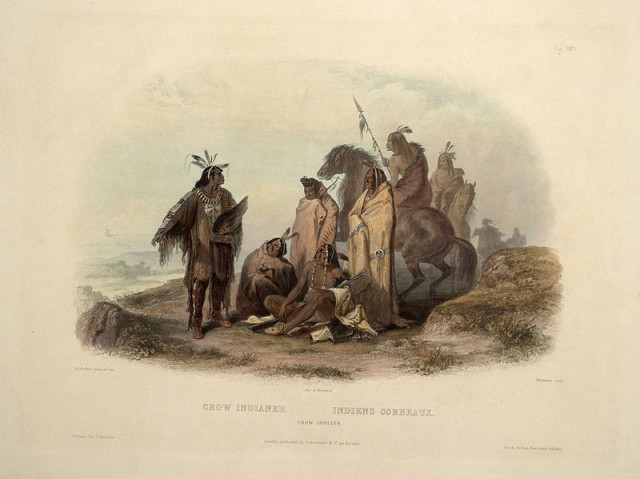 Crow indians
Crow indiansCrow Chief Plenty Coups had a vision as a child that if his nation was to survive, it would need to befriend the coming white man. He stuck to that his entire life, and upon his death in the 1920s; he donated his home to the National Park Service.
The Crow were originally from Lake Erie, but in the 1700s were pushed Westward by other tribes to first Manitoba, and then by the Cheyenne and Sioux into Montana. The Crow territory included Little Big Horn, and in 1851, that land was included in the reservation boundaries set by the U.S. government for the Crow nation.
For decades, nearly a century, before the formation of the Crow reservation and the Crow’s alliance with the U.S., the Cheyenne, and Sioux had been stealing Crow horses and warring with the less armed nation on a regular basis. They were, in a sense, bullies.
In 1868, after battling with the Sioux, the U.S. signed the Treaty of Fort Laramie, which gave the Lakota Sioux territory up to the crest of the Bighorn Mountains. The Sioux treatment of the Crow became worse, and in the two years leading up to the battle with Custer, it escalated and it further involved the U.S. Army.
The Crow did not have enough numbers to defend themselves and neither did the Army, but together they were better off. Sioux made numerous raids on the Crow and Army outposts, and the Crow would often sacrifice their warriors in attempts to recover stolen horses and goods.
Indian Agent Dexter Clapp began to plead with the government for assistance in helping the Crow. He said, “As long as they are being driven from point to point, there is no use asking them to settle down and farm.” Clapp himself, in the meantime, armed the Crow with guns and ammunition. “The Sioux are now occupying the eastern and best portion of their reservation, and by their constant warfare, paralyzing all efforts to induce the Crows to undertake agriculture.”
It wasn’t only the Crow that were being pushed around by the Sioux; other nations included Shoshone, Blackfeet, and Arikaras.
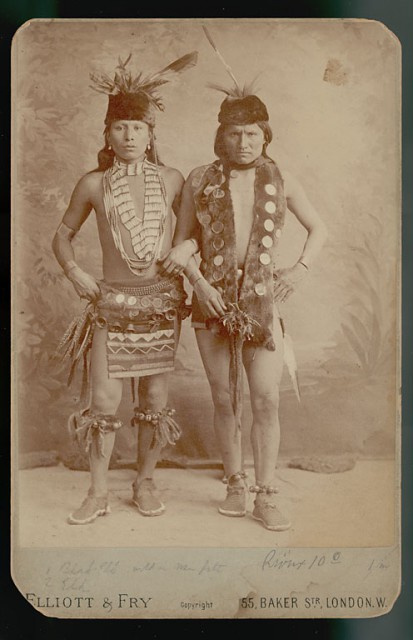 Black Elk and Elk – Oglala Lakota
Black Elk and Elk – Oglala LakotaDuring the battle, in addition to scalps, the Sioux took things from the soldier’s bodies that intrigued them.
Watches were seen only as an object that ticked, and once the ticking stopped, they were mostly discarded. Black Elk says of one that he took from a soldier’s belt “It was round and bright and yellow and very beautiful, and I put it on me for a necklace. At first, it ticked inside and then it did not anymore.”
They also found compasses and saw that the needle floated and moved when the compass case was turned. Because of their position to the bodies of the dead soldiers, the compass happened to point at the bodies. They concluded that the device was attuned to the soldiers, and that’s how the white men found each other.
Paper money was of no use as it was seen as green art and was given to the children or thrown away. The wallets, however, were worth more and were kept – an interesting and opposite perspective than ours, but probably more correct.
The Warriors also found flasks. They assumed the strong, burning liquid inside was “holy water” and that it was this drink that made the soldiers act strangely – shooting at each other and committing suicide in panic.
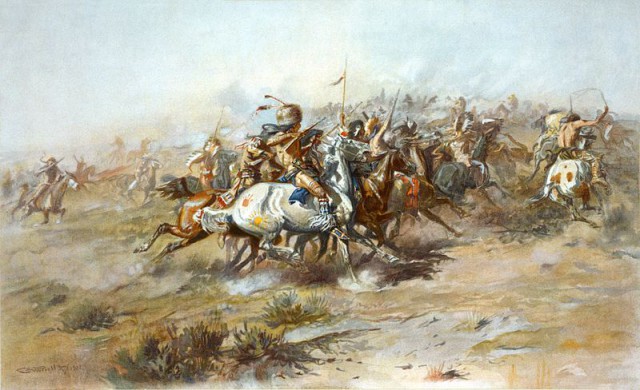 Battle of Little Bighorn
Battle of Little BighornAfter Custer himself fell, the remaining soldiers fled in a disorganized panic toward a stand of cottonwood. The stampede was such that an Indian warrior compared it with a “hunting buffalo”.
“The white men went crazy. Instead of shooting us, they turned their guns upon themselves. Almost before we could get to them, every one of them was dead. They killed themselves.” – Wooden Leg
“More and more soldiers were getting off their horses, preferring to hide or crawl along the ground . . . As hundreds of Indians surrounded this ridge, I saw one of the soldiers point his pistol at his head and pull the trigger. Others imitated his example, sometimes shooting themselves, sometimes each other. When Chief Lame White Man reached the soldiers, all of them were already dead. Indians then attacked the first ridge, and again, most of the white men were already dead. The only thing remaining for the Indians to do was pick up the abandoned guns and ammunition.” – Kate Bighead
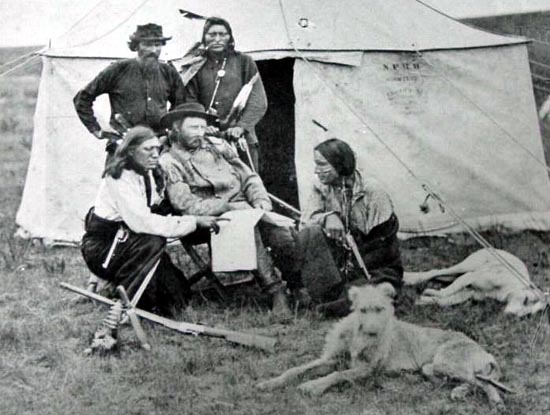 Custer and his dogs with Crow Scouts
Custer and his dogs with Crow ScoutsThere were, of course, horses at Little Big Horn, but there were also other animals – pets among them.
Custer wrote home to his wife “Tuck regularly comes when I am writing, and lays her head on the desk, rooting up my hand with her long nose until I consent to stop and notice her. She and Swift, Lady and Kaiser sleep in my tent.” His dogs were trained to run alongside his horse that could be how Tuck died in the battle. The other dogs had been left at camp with their caretaker.
The horses have far stranger stories. Aside from the trench of horses mentioned above, there were mysterious horses like Little Soldier, the horse of Bobtailed Bull, an Arikara scout working with Major Marcus Reno. After Bobtailed Bull had died in battle, Little Soldier made his way over 300 miles back to his home in the Dakota Territory.
Another horse was found by General Godfrey on the Yellowstone River. It was missing nothing. It had its halter, saddle, and bit – everything down to the oats to feed it. The saddle bags were empty, but the general was told that they did hold a carbine when first discovered. The horse had been shot in the forehead. There was no sign of the rider.
A horse that showed up in Canada after its sale by the Sioux was recovered by the Mounties, and after U.S. approval, the RMP superintendent, James Morrow Walsh was allowed to keep it. He named him “Custer”.
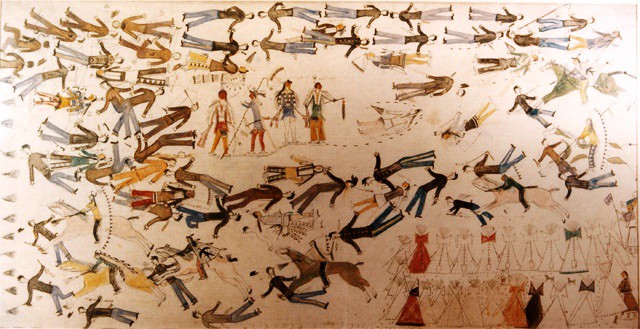 Battle of Greasy Grass
Battle of Greasy GrassThere are several paintings of the battle done by Indians, the most famous of which was done by Kicking Bear, a Sioux warrior and a later performer in Buffalo Bill Cody’s Wild West show. From his perspective, the central focus is himself, Crazy Horse, Rain In The Face, and Sitting Bull. It also features Custer and the departing spirits of the deceased. Red Horse pictographic account of the Battle of the Little Bighorn, 1881
Red Horse pictographic account of the Battle of the Little Bighorn, 1881
Red Cloud also shared his perspective in a pictograph.
Captain Grant Marsh of the Far West Steamboat was the first to deliver the news of what happened at Custer’s Last Stand. His mission had been to take supplies to Custer, but instead, he ferried 51 wounded soldiers away from the massacre.
To do this, he had to drop some weight. Rather than drop the fuel needed for steam, or supplies needed for the men, he chose to drop $375,000 worth of gold bars on the shores of the Bighorn River. It has never been recovered.
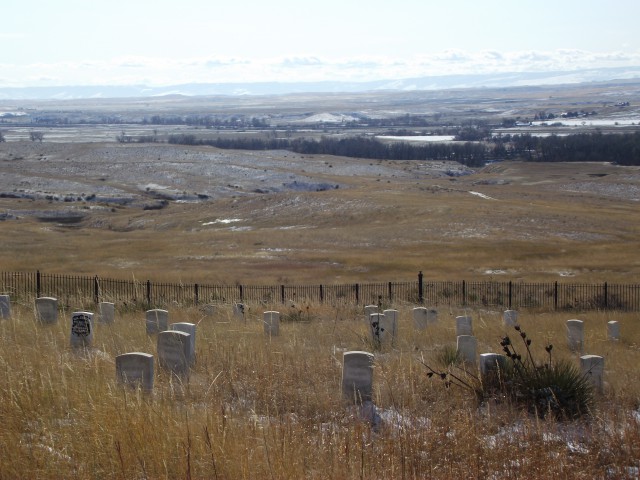 Little Bighorn Battlefield National Monument Montana. By 1025wil CC BY-SA 3.0
Little Bighorn Battlefield National Monument Montana. By 1025wil CC BY-SA 3.0If you visit the battlefield at Little Big Horn, there is a visual cue for gaining perspective on how the battle went down.
Each marble marker marks the spot where a soldier fell. Originally, they were buried where they died, but the bodies were moved later. The markers remain.
The places where the soldiers fell are marked with white marble headstones, so from afar you can get a picture of what the aftermath looked like.
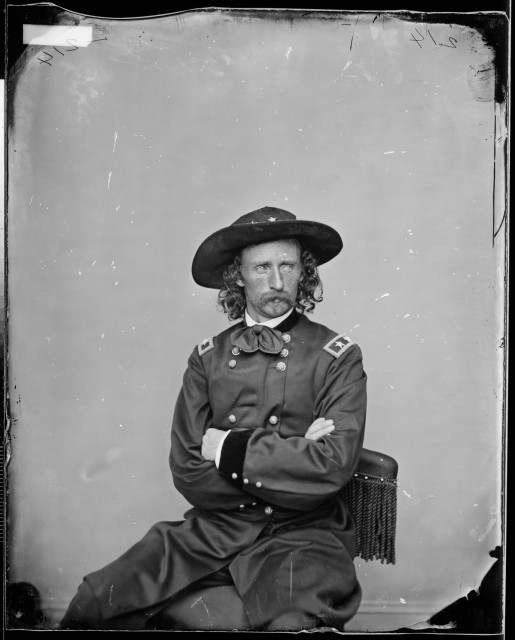 Gen. George A. Custer
Gen. George A. CusterCuster’s life is a mishmash of failure, brazen luck, and some success, but he wasn’t the hero or anti-hero portrayed in movies.
He was known as a prankster at West Point and graduated as the lowest ranking cadet.
Most people believe he was a general, and he was for a while during the Civil War – a Brevet Major General. After the war, the rank reverted to Captain and remained so for the rest of his career.
He was court martialed twice – once for going AWOL to visit his wife.
During a campaign in Texas, the soldiers continually gave him gruff and balked at his discipline, and thought of him as a “vain dandy.” Custer was known for his appreciation of his hair and his attention to it with cinnamon oil for scent and other treatments.
Most of the legend surrounding Custer was embellished or even made up by Custer’s wife during speeches throughout her life, and by the shows put on by a friend and fellow soldier, Buffalo Bill.
It’s amazing what modern archeology and good investigation can accomplish.
Studies underway at Little Big Horn Battlefield National Monument are so advanced that researchers can find a bullet on the ground and track where it was shot from, who shot it, and how adept at fighting the soldier was.
They conduct their research with metal detectors and microscopes and match firing pins to rifle cartridges. They are also working with new translations of Native American accounts of the battle.
This is crap.

Yellow hair's wife, not too shabby.
Yes, the whole series is good; for my money The Frontiersman is the best of them... good stuff.
That was a really good book. I think about it when I have to drive through Kenton County, on the way to Cincinnati.
George Armstrong Custer was no hero. He was a disgrace.
Thanks vannrox.
It was Custers boldness that forced Lees surrender at Appomattox on April 9th.
There was a charge on cannons to take the baggage train.
Then they positioned a skirmish line over the line of retreat.
Some infantry was rushed up to help hold the line.
The Confederates made a token attack to try to break out... then after a pause, arranges the surrender ...
Lee gave Custer the desk that the surrender was signed on - because he was most responsible for the surrender.
That’s from memory, no go look up the official story.
The Indians had already stopped and turned back the army advancing from the South.
Custer was with the Northern army. His force was sent out to find and locate the Indians.
Most of the officer thought the Unduabs would try to slip away - to save their families and possessions.
Custer was a great Civil War hero.
Here is the official story of the battle of Appomattox court house.
https://en.m.wikipedia.org/wiki/Battle_of_Appomattox_Station
Excerpt:
“Custer’s entire First Brigade under Colonel Pennington then came forward behind a large group of skirmishers and continued the uncoordinated attack started by his lead regiments.[61][91] They also were driven back by the Confederate skirmishers and artillery.[61][91] Undeterred by these setbacks,
Custer was determined to capture the Confederate artillery and hold a position on the Lynchburg road.[92]
After Colonel Henry Capehart’s Third Brigade followed Pennington’s men on to the field, Custer sent all of his men against the Confederate position.[92] Nearly 50 Union troopers were felled by canister used by the Confederate artillerymen.[92]
When Colonel (Brevet Brigadier General) William Wells’s Second Brigade arrived, Custer continued the attack as dark came on, even though thick woods sheltered the Confederate position.[92][93] Even with the addition of Wells’s brigade another Union assault failed.[94] Historian William Marvel credits the support of Gary’s troopers and Colonel T. M. R. Talcott’s (armed) engineers along with Walker’s heavy ordnance for the strong showing and lengthy holdout by Walker’s men.[95]
Custer then personally led an assault with his entire force but without a breakthrough.[notes 17][96]
At about 9:00 p.m., under the light of a full moon, Custer’s entire division again assaulted and finally broke the Confederate line.[95] The Confederates began to withdraw, abandoning many of their active guns, caissons and baggage wagons which then were captured by Custer’s men.[4][97] The gradual dispersal of Walker’s cannons and men and the withdrawal of Gary’s and Talcott’s men weakened Walker’s remaining defense to the point of collapse upon Custer’s final charge.[95]
The Confederate withdrawal from the Lynchburg stage road at this location allowed the Union cavalry to occupy a segment of the road and block the Confederate escape route toward Lynchburg.[93]
The Appomattox River was not fordable in this vicinity, which prevented a Confederate escape to the north, an option without much possible benefit in any event.[93]
Union troops blocked the Army of Northern Virginia’s movements in the other directions.[98]. End
Utter Rubbish. Custers promotions.
Custer was a fearless fighter who always led his men. He was always in the thick of the fighting. Custer’s excellent fighting and leadership abilities were one of the reasons the Union won the Civil War.
“Custer’s promotions and ranks including his six brevet [temporary] promotions which were all for gallant and meritorious services at five different battles and one campaign:[41]
Second Lieutenant, 2nd Cavalry: June 24, 1861
First Lieutenant, 5th Cavalry: July 17, 1862
Captain Staff, Additional Aide-De-Camp: June 5, 1862
Brigadier General, U.S. Volunteers: June 29, 1863
Brevet Major, July 3, 1863 (Battle of Gettysburg, Pennsylvania)
Captain, 5th Cavalry: May 8, 1864
Brevet Lieutenant Colonel: May 11, 1864 (Battle of Yellow Tavern - Combat at Meadow)
Brevet Colonel: September 19, 1864 (Battle of Winchester, Virginia)
Brevet Major General, U.S. Volunteers: October 19, 1864 (Battle of Winchester and Fisher’s Hill, Virginia)
Brevet Brigadier General, U.S. Army, March 13, 1865 (Battle of Five Forks, Virginia)
Brevet Major General, U.S. Army: March 13, 1865 (The campaign ending in the surrender of the Army of Northern Virginia)”
Major General, U.S. Volunteers: April 15, 1865
Mustered out of Volunteer Service: February 1, 1866
Lieutenant Colonel, 7th Cavalry: July 28, 1866 (killed at the Battle of the Little Bighorn, June 25, 1876)
One of Custers first actions... He took a Confederare Battle flag !
“...General Barnard and his staff were reconnoitering a potential crossing point on the Chickahominy River, they stopped, and Custer overheard Barnard mutter, “I wish I knew how deep it is.”
Custer dashed forward on his horse out to the middle of the river, turned to the astonished officers, and shouted triumphantly, “That’s how deep it is, Mr. General!”[11]
Custer was allowed to lead an attack with four companies of the 4th Michigan Infantry across the Chickahominy River above New Bridge.
The attack was successful, resulting in the capture of 50 Confederate soldiers and the seizing of the first Confederate battle flag of the war.
McClellan termed it a “very gallant affair” and congratulated Custer personally.”
Source. https://en.m.wikipedia.org/wiki/George_Armstrong_Custer
As I am not American I am rather ignorant of most US history. Learned recently that a backroom deal put Hayes into power. The election was disputed in 3 southern states, so both factions met together giving the Presidency to Hayes, but removing troops from the south - which apparently lead to major erosion of black rights in the South.
Would you say that is an accurate account?
I am curious on finding a clear and honest account of Reconstruction. Seems like there two opposing views on what Reconstruction was about.
So water boarding is worse?
Without a doubt. Much, much worse.
I don’t give a damn about his promotion’s. He was a terrible soldier , a rotten officer and an even worse human being.
Clearly Custers superiors completely disagree with your position.
He was an extremely effective Cavalry officer for the Union.
Well, let me ask you.
When the electoral college cannot reach a decision, what is the process specified by the U.S. Constitution ?
“Union Gen. Phillip Sheridan purchased the table on which Gen. Ulysses S. Grant wrote the surrender terms for Lee to sign, and presented it to Custer with a note to Custer’s wife.
It said: “Permit me to say, madam, that there is scarcely an individual in our service who has contributed more to bring about this desirable result than your gallant husband.””
Disclaimer: Opinions posted on Free Republic are those of the individual posters and do not necessarily represent the opinion of Free Republic or its management. All materials posted herein are protected by copyright law and the exemption for fair use of copyrighted works.